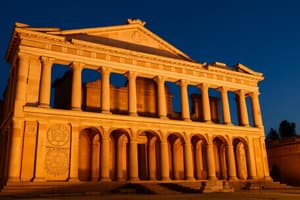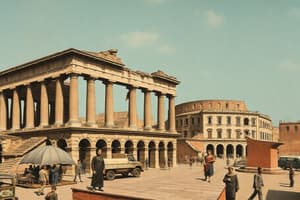Podcast
Questions and Answers
What action led to the death of Remus according to the common account?
What action led to the death of Remus according to the common account?
- He challenged Romulus to a duel
- He leaped over Romulus's wall (correct)
- He stole Romulus's weapons
- He insulted Romulus
What period did the Etruscans rule Rome?
What period did the Etruscans rule Rome?
- 509-27 BCE
- 753-509 BCE
- 1000-753 BCE
- 616-509 BCE (correct)
Which of the following is NOT a contribution of the Etruscans to Rome?
Which of the following is NOT a contribution of the Etruscans to Rome?
- Fasces
- The Senate (correct)
- Cloaca Maxima
- The Roman alphabet
What was the significance of the fasces in Roman culture?
What was the significance of the fasces in Roman culture?
Which feature of early Roman infrastructure was attributed to the influence of the Etruscans?
Which feature of early Roman infrastructure was attributed to the influence of the Etruscans?
Which statement about Etruscan religion is correct?
Which statement about Etruscan religion is correct?
What characterized the governance during the Monarchy period according to the content?
What characterized the governance during the Monarchy period according to the content?
How was the rank of Roman officials denoted by the fasces?
How was the rank of Roman officials denoted by the fasces?
Which nation was the primary adversary of Rome during the Punic Wars?
Which nation was the primary adversary of Rome during the Punic Wars?
What year marks the beginning of the Punic Wars?
What year marks the beginning of the Punic Wars?
Who is the legendary hero in Vergil's Aeneid that is associated with the founding of Rome?
Who is the legendary hero in Vergil's Aeneid that is associated with the founding of Rome?
Which of the following events occurred during the early third century BC?
Which of the following events occurred during the early third century BC?
What role did Hannibal play in the Punic Wars?
What role did Hannibal play in the Punic Wars?
Who is Aeneas in relation to the founding of Rome?
Who is Aeneas in relation to the founding of Rome?
What significant event marks the founding of Rome?
What significant event marks the founding of Rome?
Which river is associated with the location of Rome?
Which river is associated with the location of Rome?
Who is credited with the founding of Rome according to Roman mythology?
Who is credited with the founding of Rome according to Roman mythology?
What type of society does the story of Aeneas and Romulus suggest Romans originated from?
What type of society does the story of Aeneas and Romulus suggest Romans originated from?
What was the role of Vergil in relation to Aeneas?
What was the role of Vergil in relation to Aeneas?
What symbol represents the idea of imperium in ancient Rome?
What symbol represents the idea of imperium in ancient Rome?
What was the ruling system of Rome between 753-509 BCE?
What was the ruling system of Rome between 753-509 BCE?
What does the symbol of fasces represent in Roman culture?
What does the symbol of fasces represent in Roman culture?
Which river is associated with the founding of Rome?
Which river is associated with the founding of Rome?
Which of the following is a characteristic detail in Livy's account of Romulus and Remus?
Which of the following is a characteristic detail in Livy's account of Romulus and Remus?
What happened after Remus and Romulus saw their omens?
What happened after Remus and Romulus saw their omens?
How did ancient Romans view their city’s early history, according to Livy?
How did ancient Romans view their city’s early history, according to Livy?
What group of people settled in Italy around 2000 BCE according to modern historians?
What group of people settled in Italy around 2000 BCE according to modern historians?
What major construction is renowned as an ancient sewer system in Rome?
What major construction is renowned as an ancient sewer system in Rome?
Which figure is known for chronicling early Roman history and citing myths like that of Aeneas?
Which figure is known for chronicling early Roman history and citing myths like that of Aeneas?
What was the duration of Etruscan rule over Rome?
What was the duration of Etruscan rule over Rome?
Which of the following was a significant Etruscan contribution to Roman culture?
Which of the following was a significant Etruscan contribution to Roman culture?
How did the Etruscans influence Roman religion?
How did the Etruscans influence Roman religion?
What triggered the end of the Etruscan monarchy in Rome?
What triggered the end of the Etruscan monarchy in Rome?
What was the purpose of the Cloaca Maxima?
What was the purpose of the Cloaca Maxima?
Which of the following describes the term 'fasces'?
Which of the following describes the term 'fasces'?
What were the two major social classes in early Roman society?
What were the two major social classes in early Roman society?
What significant event occurred in 509 BCE?
What significant event occurred in 509 BCE?
What was the primary role of the consuls in the Roman Republic?
What was the primary role of the consuls in the Roman Republic?
What significant change did the Lex Canuleia introduce in 445 BC?
What significant change did the Lex Canuleia introduce in 445 BC?
What year marks the beginning of the Roman Republic following the Monarchy?
What year marks the beginning of the Roman Republic following the Monarchy?
Which assembly was responsible for electing certain officials in the Roman Republic?
Which assembly was responsible for electing certain officials in the Roman Republic?
What was the outcome of the plebeian Secessio in 494 BC?
What was the outcome of the plebeian Secessio in 494 BC?
What was a primary function of the Senate in the Roman Republic?
What was a primary function of the Senate in the Roman Republic?
Which legal document codified Roman laws in 449 BC?
Which legal document codified Roman laws in 449 BC?
How long was the term for a dictator during a crisis in the Roman Republic?
How long was the term for a dictator during a crisis in the Roman Republic?
Flashcards
Etruscan Influence on Rome
Etruscan Influence on Rome
The Etruscan civilization, powerful from 1000-509 BCE, greatly influenced Roman culture and the city of Rome.
Fasces
Fasces
A symbol of political authority in ancient Rome, consisting of a bundle of rods tied with red thongs (sometimes with an axe).
Etruscan Monarchs in Rome
Etruscan Monarchs in Rome
The Etruscan rulers of Rome from 616 to 509 BCE.
Anthropomorphism in Roman Religion
Anthropomorphism in Roman Religion
Signup and view all the flashcards
Cloaca Maxima
Cloaca Maxima
Signup and view all the flashcards
Etruscan Alphabet
Etruscan Alphabet
Signup and view all the flashcards
Livy
Livy
Signup and view all the flashcards
Latium
Latium
Signup and view all the flashcards
Romulus
Romulus
Signup and view all the flashcards
Remus
Remus
Signup and view all the flashcards
Roman Gods
Roman Gods
Signup and view all the flashcards
Roman Republic
Roman Republic
Signup and view all the flashcards
Aeneas
Aeneas
Signup and view all the flashcards
Virgil
Virgil
Signup and view all the flashcards
Romulus and Remus
Romulus and Remus
Signup and view all the flashcards
Palatine Hill
Palatine Hill
Signup and view all the flashcards
Tiber River
Tiber River
Signup and view all the flashcards
Etruscan Rule in Rome
Etruscan Rule in Rome
Signup and view all the flashcards
Roman Monarchy
Roman Monarchy
Signup and view all the flashcards
Etruscan Influence on Roman Culture
Etruscan Influence on Roman Culture
Signup and view all the flashcards
Imperium
Imperium
Signup and view all the flashcards
Tarquin the Proud
Tarquin the Proud
Signup and view all the flashcards
Lucretia
Lucretia
Signup and view all the flashcards
Dictator
Dictator
Signup and view all the flashcards
Consuls
Consuls
Signup and view all the flashcards
Senate
Senate
Signup and view all the flashcards
Assemblies
Assemblies
Signup and view all the flashcards
Struggle of the Orders
Struggle of the Orders
Signup and view all the flashcards
Secessio Plebeian Walk-Out
Secessio Plebeian Walk-Out
Signup and view all the flashcards
Twelve Tables
Twelve Tables
Signup and view all the flashcards
What were the Punic Wars?
What were the Punic Wars?
Signup and view all the flashcards
Who was Hannibal?
Who was Hannibal?
Signup and view all the flashcards
What were the main causes of the Punic Wars?
What were the main causes of the Punic Wars?
Signup and view all the flashcards
What was the outcome of the Punic Wars?
What was the outcome of the Punic Wars?
Signup and view all the flashcards
What does "Punic" mean?
What does "Punic" mean?
Signup and view all the flashcards
Study Notes
Roman History Overview
- The Roman Republic was preceded by a monarchy.
- The Republic lasted from 509 BCE to 27 BCE.
- The Punic Wars fundamentally shaped Rome's rise to power.
- Key figures like Aeneas and Dido played important roles in early Roman myths.
- The Struggle of the Orders was a significant political conflict.
- The 12 Tables were a crucial codification of Roman Law.
- Roman expansion led to conflicts with other nations and empires.
- The story of Rome reflects a diverse range of cultural influences.
- Roman government evolved from a monarchy to a republic, and then an empire.
Key People and Concepts
- Livy: Historian who documented Roman history.
- Romulus: Mythical founder of Rome, believed to have established the city.
- Remus: Mythical co-founder of Rome
- Etruscans: Powerful people who influenced early Rome's political and cultural development.
- Aeneas: Trojan hero, key figure in Roman foundational myths.
- Dido: Queen of Carthage, featured in Roman myths and linked to the Punic Wars and Aeneas.
- The Punic Wars: A series of wars between Rome and Carthage, pivotal in Rome's rise as a dominant power.
- The Twelve Tables: A fundamental code of Roman laws, establishing basic legal concepts.
- Monarchy: A government ruled by a single person, king or emperor.
- Republic: A government in which citizens elect representatives to make decisions on their behalf.
- Senate: A political assembly of prominent citizens, an important part of the Roman Republic.
- Consuls: The chief elected officials of the Roman Republic, responsible for governing the Republic.
- Veto: The power to reject a proposal or decision.
- Assemblies: Groups of citizens who voted on laws within specific structures.
Studying That Suits You
Use AI to generate personalized quizzes and flashcards to suit your learning preferences.
Related Documents
Description
Test your knowledge on the Etruscan influence on Rome and the key events of the Punic Wars. This quiz covers aspects of governance, religion, and legendary figures from ancient Rome, highlighting important contributions and conflicts. Perfect for students of Roman history or anyone interested in classic civilizations!




